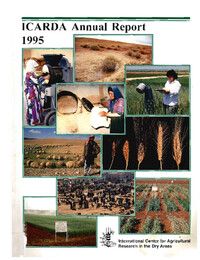ICARDA Annual Report 1995

Authors:
Achieving sustainable increases in agricultural productivity in dry areas presents a significant challenge. These regions are characterized by low and variable rainfall, limited conventional water resources, and a continually decreasing share of water available for agriculture. Many dry areas are located in the southern regions, where population growth rates are high, leading to an ever-increasing gap between food demand and supply. The growing population exerts pressure on the already fragile resource base.
There is little opportunity to expand arable land, which means the rising demand for food and feed must be addressed through yield increases. This can be achieved by applying biotechnological tools for crop genetic improvement and developing better production practices that sustainably utilize natural resources. In this context, the International Center for Agricultural Research in the Dry Areas (ICARDA) plays a crucial role in developing and transferring improved technologies. Their work contributes to alleviating poverty and hunger while also protecting the environment in these regions.
If the challenges related to agricultural production in dry areas are not effectively addressed, the consequences could include increased poverty and hunger, leading to socio-political instability and environmental degradation. This could have serious implications at national, regional, and international levels.
